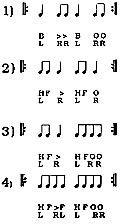"A good drummer listens as much as he plays." ~ Indian Proverb
Percussion Store Drummers Drum Lessons Drumming FAQs
International Shipping
"A good drummer listens as much as he plays." ~ Indian Proverb
Percussion Store Drummers Drum Lessons Drumming FAQs
International Shipping
![]()
![]()
Drums & Percussion
Drum Sets & Cymbals
Cymbals, Hardware & Accessories
Latin Percussion
LP Hardware, Accessories & Replacement Parts
Middle-East Drums & Percussion
African Drums & Accessories
Chinese & Eastern Drums & Percussion
Irish Drums & Percussion
Orchestra Bells & Chimes
Drum & Percussion Hardware
![]()
by Richie Garcia
Developing a knowledge of Afro-Cuban rhythms and the numerous instruments used to play these rhythms can be a massive undertaking. Although it's always good to gather as much information as possible, concentrating on a little bit at a time will assist you in firmly understanding all the instruments and how they're used. In order to help you understand some very basic ideas, this article will deal with an introduction to conga drums, and some basic exercises. I hope this information will be useful to you in your pursuit of percussion knowledge.
Conga drums come in three basic sizes.
1) Quinto, is the smallest drum, and is commonly used for solos.
2) Conga, the middle size drum is used to answer patterns played on a
tumbadora.
3) Tumbadora, the largest of the three drums is used to lay down the
foundation of the specific rhythm being played.
Four basic hand techniques are used on conga drums which create different sounds. Sometimes different signs are used to identify the these techniques on paper, but the technique and sound desired remains the same.

Although you have a basic description of how to do these motions, the best way to really learn these techniques is to have an accomplished conga player demonstrate them to you and help you get them right.
Congas for Sale
LP Congas - Premium Congas
Matador Congas - Advanced & Intermediate Congas
Aspire Congas - Intermediate & Beginner Congas
CP Congas - Advanced Mini Congas
Drums Lessons